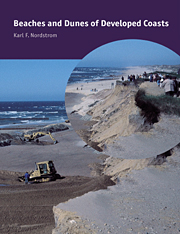Book contents
- Frontmatter
- Contents
- Preface
- Acknowledgements
- 1 The developed coastal landscape: temporal and spatial characteristics
- 2 Altering landforms to suit human needs
- 3 Replenishing landforms
- 4 Effects of structures on landforms and sediment availability
- 5 Characteristics of human-altered coastal landforms
- 6 Temporal scales of landscape change
- 7 Management programs
- 8 Maintaining and enhancing natural features in developed landscapes
- 9 Directions for geomorphological research
- References
- Index
5 - Characteristics of human-altered coastal landforms
Published online by Cambridge University Press: 18 December 2009
- Frontmatter
- Contents
- Preface
- Acknowledgements
- 1 The developed coastal landscape: temporal and spatial characteristics
- 2 Altering landforms to suit human needs
- 3 Replenishing landforms
- 4 Effects of structures on landforms and sediment availability
- 5 Characteristics of human-altered coastal landforms
- 6 Temporal scales of landscape change
- 7 Management programs
- 8 Maintaining and enhancing natural features in developed landscapes
- 9 Directions for geomorphological research
- References
- Index
Summary
Introduction
The great variation in types and intensities of human actions affecting landforms identified in chapters 1 to 4 results in great variation in their characteristics. These landform characteristics are evaluated in this chapter in terms of location, dimensions, orientation, topographic variability, sediment characteristics and mobility. The purpose is to place human actions (or non-actions) into perspective as either intrinsic or extrinsic to landform evolution and place landforms in perspective in terms of the degree to which they are natural features or artifacts. The temporal and political dimensions of landform evolution are addressed to show how human actions affect coastal conversions at scales of landforms and landscapes.
Locations of landforms
Beaches
A focus on erosion problems on fully developed shores, where beaches are narrow and the waves break close to coastal structures, conveys the impression that beaches in these areas are farther landward than they would occur under undeveloped conditions. Often, it is more true to say that the landward portion of the beach is farther seaward than its natural counterpart because human encroachment on the backbeach prevents the beach from moving inland at the expense of the developed upland.
Nourishment operations used to restore dimensions of beaches that previously existed and to create beaches where they would not occur under natural conditions extend the beach farther seaward, displacing the location of the breakers and surf farther offshore. Structures built for shore protection and navigation improvement may enhance accretion and displace the zone of wave action seaward in the accretion zone but accelerate the process of land ward displacement in down drift areas. Viewed in the long term, the net result of human action contributes to maintaining beaches within a more restricted zone than under natural conditions but also farther seaward.
- Type
- Chapter
- Information
- Beaches and Dunes of Developed Coasts , pp. 140 - 164Publisher: Cambridge University PressPrint publication year: 2000



